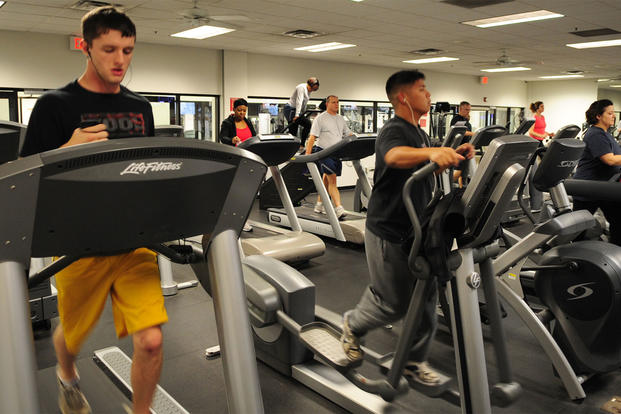Over the years, I have had the honor of working with people who wanted to serve but were overweight and didn’t meet the height and weight standards required by our military's recruitment process. Unfortunately, not meeting those height and weight standards is now the number one reason why young men and women cannot join the military.
Previous generations of Americans have faced a lack of education, criminal records and medical issues as the primary reasons for not being qualified to join. With more than 70% of our population considered overweight or obese, the pool of applicants who qualify for service is smaller than ever before. We're now at the point where obesity can be considered a national security threat.
If you are considering military service, but currently overweight, do not think you cannot serve. I have seen many people drop 50, 75, 100, even 150 pounds to meet the standards to serve.
When we decide to serve, we all will arrive at the recruitment table with a variety of strengths and weaknesses, given our academic and athletic backgrounds. The military still needs you.
You may be a strong former football player and overweight and want to be an Army Ranger. The military still needs you.
There are so many jobs the military needs to fill each year, ones that offer great training and incentives for a young person wanting to start a career, but you must get into military shape and lose weight before you visit a recruiter. The good news is that you can do both at the same time.
Consider this multi-pronged attack on your goals to meet and exceed the recruitment standards of the military.
Move More
You must get out and move more throughout the day. Walking is a perfect start. Finding a job that requires you to keep moving or just making time in your day to move is critical to your daily caloric burn. Keep track of your daily steps with the pedometer on your phone and strive for at least 10,000 a day, but it is fine to try for 15,000 steps.
Obviously, this is spread throughout the day as the goal is to do this steadily and not all at once. You can lose two pounds a week by walking 10,000 steps a day with a moderate food intake. Obviously, progressing to 10,000 a day may take a few months, so start off with a fraction of that.
Move More (Part 2)
Non-impact Options: If you are severely overweight, you may find walking very challenging. If you weigh 280 pounds and have a goal of weighing 200 pounds to meet the military standards for your height and weight, your current situation is the same as rucking with an 80-pound backpack for a 200-pound person.
Your knees, hips and lower back will feel the strain, so finding non-impact options should make up more than 50% of your cardio time. Walking 10,000 steps typically takes a total time of 100 minutes.
It is fine to walk for some of that daily goal, but you may want to choose biking, rowing, elliptical, or swimming for 50%-66% of your cardio time. Depending on how you are feeling, you may have to resort to 100% of your time doing non-impact cardio activity and build up to walking as you lose some weight over time.
Resistance Training
You also must build a foundation of strength through calisthenics and weighted movements. Strength training can start off light with calisthenics. As you get better at higher repetitions, add weight to the same movements. These movements are push-ups (weight vest or bench press), pull-ups (or pulldowns), squats, lunges and plank poses. Start off with calisthenics and then add weight with weight vests, sandbags, dumbbells, barbells and suspension training with devices like the TRX.
Reduce Calories and Eat Better
Portion control is the number one issue for Americans, but so are the choices of what and how we eat. Good nutrition starts with eating more fruits, vegetables and lean protein sources and reducing processed food, desserts, sodas and fried foods. This can be the hardest part of this journey.
To be honest, the easy part will be moving more for 1-2 hours a day. The hard part is how easy it is to eat during the other 22-23 hours of the day. Find a way to eat that works for you.
Personally, I make a food diary and force myself to write down everything that I put into my mouth, including meals, snacks, drinks and water totals. This activity reveals so much and usually finds the holes in your diet.
Try different options like intermittent fasting or Keto to start, but in the end, you will have to find a long-term solution that will include eating fewer calories a day and making those incoming calories actually count toward a nutritious day of eating.
Replace All Soda with Water
Drinks high in sugar (sodas, coffees, juices, energy drinks) need to be replaced with water. There are numerous examples of people losing 25-50 pounds in a year by simply replacing all soda with water and starting a walking plan.
Routine and Patience Are Key
Make it a habit to do something physical every day and mind your caloric intake, as the two sides of this equation depend on each other for success. Once you find yourself at a healthy running weight for your frame, mix in more walks and runs as you build up to timed run distances.
Give yourself time to do all the parts of this weight-loss routine. It may take six months to a year or more to lose weight healthfully, find a food plan that allows for weight loss and fitness performance, and slowly evolve from a walker to a runner. Beginner Running Plan
Successful weight loss is a combination of the elements above (moving more, resistance training, eating better and drinking more water). You can do it if you want to lose weight in order to serve or just for your own health reasons. If you can accomplish this task, you will be well on your way with self-confidence, determination and grit needed to be a service member. Good luck.
Stew Smith is a former Navy SEAL and fitness author certified as a Strength and Conditioning Specialist (CSCS) with the National Strength and Conditioning Association. Visit his Fitness eBook store if you're looking to start a workout program to create a healthy lifestyle. Send your fitness questions to stew@stewsmith.com.
Want to Learn More About Military Life?
Whether you're thinking of joining the military, looking for fitness and basic training tips, or keeping up with military life and benefits, Military.com has you covered. Subscribe to Military.com to have military news, updates and resources delivered directly to your inbox.



















